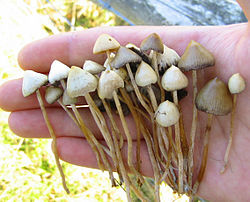A

- Psilocybe acadiensis A.H.Sm.
- Psilocybe acutipilea (Speg.) Guzmán
- Psilocybe aerugineomaculans (Hohn.) Singer & A.H. Sm.
- Psilocybe allenii Borov., Rockefeller & P.G.Werner
- Psilocybe alutacea Y.S. Chang & A.K. Mills
- Psilocybe angulospora Yen W. Wang & S.S. Tzean
- Psilocybe angustipleurocystidiata Guzmán
- Psilocybe antioquiensis Guzmán, Saldarr., Pineda, G. Garcia & L.-F. Velazquez
- Psilocybe atlantis Guzmán, Hanlin & C. White
- Psilocybe aquamarina (Pegler) Guzmán
- Psilocybe aucklandiae Guzmán, C.C. King & Bandala
- Psilocybe aztecorum R. Heim
- Psilocybe azurescens Stamets & Gartz


